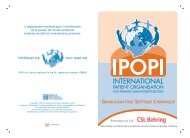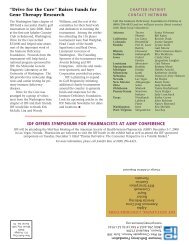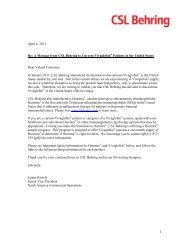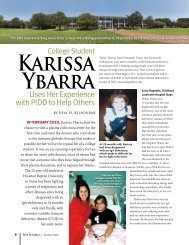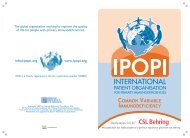IDF Patient & Family Handbook for Primary Immunodeficiency ... - IDFA
IDF Patient & Family Handbook for Primary Immunodeficiency ... - IDFA
IDF Patient & Family Handbook for Primary Immunodeficiency ... - IDFA
You also want an ePaper? Increase the reach of your titles
YUMPU automatically turns print PDFs into web optimized ePapers that Google loves.
116 Adolescents with <strong>Primary</strong> <strong>Immunodeficiency</strong> Diseases<br />
Your Adolescent’s Healthcare Providers<br />
Some adolescents may experience few medical<br />
problems that are related to their primary<br />
immunodeficiency disease while others may<br />
have very complex medical concerns that involve<br />
a number of physicians and other healthcare<br />
providers. Maintaining good communication<br />
with, and among, these providers is important to<br />
effectively manage a primary immunodeficiency<br />
disease. Clear and accurate in<strong>for</strong>mation about both<br />
the history and current status of your adolescent’s<br />
health condition is needed by all who will be<br />
providing care. Healthcare providers need to know<br />
exactly what your adolescent is experiencing and<br />
how each of the providers is contributing to your<br />
adolescent’s care.<br />
To maintain clear communication and good<br />
teamwork with healthcare providers, keep a diary<br />
or notebook outlining your adolescent’s symptoms<br />
and treatments. Prior to a visit or phone call with<br />
your healthcare provider), use these notes to<br />
summarize your adolescent’s current condition<br />
and plan any specific questions that you may<br />
have. Ask all healthcare providers to provide you<br />
with copies of all major treatment summaries,<br />
laboratory and diagnostic test results, and<br />
correspondence. When requested by healthcare<br />
providers, help make sure that they are also<br />
copied with reports from other providers. Keep<br />
these organized in your adolescent’s healthcare<br />
notebook as a reference <strong>for</strong> new providers.<br />
Including adolescents in helping with this<br />
communication process will help then be ready <strong>for</strong><br />
their adult role of managing their own healthcare.<br />
Transitioning from late adolescence into young<br />
adulthood may involve changing healthcare<br />
providers. This may occur as they move away<br />
from home to attend college or begin a career. For<br />
others, the transition occurs as older adolescents<br />
are shifted from pediatric care providers to adult<br />
care providers. Discuss this with current physician<br />
and healthcare providers <strong>for</strong> the best way to<br />
manage these care transitions.<br />
There may be times that are particularly stressful<br />
in family life. This may be from significant<br />
changes in family life, such as a change in parent<br />
employment, financial changes, a move, divorce<br />
or death. Or, the stress may be more directly<br />
related to coping with a primary immunodeficiency<br />
disease. Whatever the source of these high levels<br />
of stress, it can impact any healthcare problem, so<br />
do not hesitate to address the sources of family<br />
stress. Your adolescent’s physician should be<br />
kept updated on these matters, so that general<br />
guidance can be offered or a referral can be<br />
made to a family counseling professional <strong>for</strong> more<br />
specific help.








